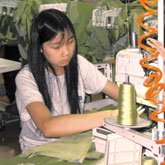The Sourcing Shine Fades From China
Higher wages, longer lead times and infrastructure issues push L.A. apparel makers to reconsider producing in China.
This November, Stony Apparel executive Dean Wiener will be hopping off a plane in Shanghai and traveling 11 hours into the Chinese hinterlands to visit a new factory being used by the Los Angeles clothing maker.
“These are the things we have to do to avoid the labor shortages found in coastal factories,” said Wiener, chief operating officer at Stony Apparel, which produces 2 million pieces of clothing for children and teens every month.
Stony Apparel is just one of many California apparel companies discovering that sourcing in China has changed in the last few years. Higher wages, a labor shortage, longer lead times, rising prices and power outages have pushed apparel companies to figure out new ways to work in China or source elsewhere as frustration mounts.
“We are finding little by little that the quality of life as we knew it by making goods in China is lessening,” said Lonnie Kane, president of Los Angeles women’s clothing company Karen Kane. “They used to do a lot of things well. Now goods don’t arrive in a timely matter. The quality is down. People at the factories have less experience, and they are not trained as well. We are getting things that are just plain wrong.”
After joining the World Trade Organization in 2001, China mushroomed into the apparel factory to the world. Goods were sewn cheaply, quickly and efficiently in mega-factories the size of small U.S. towns. Lean manufacturing and low wages kept this Asian nation of 1.3 billion people the go-to place for everything from lace blouses to sparkly evening gowns.
By the end of 2008, quotas on Chinese-made apparel had completely disappeared, sending another wave of production there.
But in the last year, apparel workers’ wages have risen at least 10 percent to 20 percent, laborers are abandoning coastal towns to work closer to their villages in newly created jobs and China’s undervalued currency has been revalued upward by 10 percent, making goods more expensive in the U.S. market.
Rising prices pushed John Poyer, head of Topson Downs Inc. in Los Angeles, to adjust his sourcing strategy this year. Now only about 30 percent of his clothing for the juniors and misses market will be done in China, compared with 50 percent last year. “China’s costs have gone up anywhere from 7 to 10 percent,” Poyer said. “We have started to branch out to Bangladesh and Cambodia.”
The bigger the company, the bigger these price hikes are. For Volcom Inc., a $280 million surfwear maker in Costa Mesa, Calif., price inflation in China is nudging it to source elsewhere. “Labor costs could go up as much as 30 percent,” said Doug Collier, the company’s chief financial officer, at a Goldman Sachs presentation in New York on Sept. 14. He noted that labor shortages, strikes and rising raw-material costs are making it harder to keep a lid on apparel prices coming out of China.
In the company’s second-quarter earnings report, it acknowledged that the surfwear maker has begun sourcing in India, Bangladesh, Vietnam and Mexico.
The smaller Asian countries are becoming popular because of their low wages. Salaries in Bangladesh, Cambodia and Vietnam are 50 percent to 80 percent lower than China’s monthly minimum salary of $200. But sometimes that isn’t enough to siphon sourcing away from the big apparel factories in China, where huge fabric mills are located nearby.
Bangladesh, Vietnam and Cambodia don’t have sophisticated, efficient highways, ports or airports to handle mammoth quantities of apparel, lengthening production lead times by as much as two to three weeks. Goods shipped by boat from Vietnam take as long as 17 days to sail to Los Angeles, compared with an 11-day journey from China.
And most of the fabric used in Vietnam, Cambodia and Bangladesh comes from China.
So, many manufacturers are sticking with China but hedging their sourcing bets by using other countries.
“I don’t think we can survive without China,” said Rakesh Lal, executive vice president of Just for Wraps Inc., whose juniorswear labels include Wrapper, A-List and Wishes, Wishes, Wishes.
Lal said his company has increased its China sourcing from 30 percent of production a few years ago to 40 percent even though prices have risen 10 percent to 15 percent. Another 40 percent of production is done in Mexico. “There are problems in China, but we do what we have to do to make it work,” he said.
To iron out the rough edges in production, Just for Wraps opened an office in Shanghai six months ago with three people to keep tabs on production. “They go from factory to factory to make sure we’re not in for any surprises,” he noted.
The company also sent its own quality-control people from Los Angeles to China to help train staff. “We have been burned by China with poor quality and late shipments, but getting our own staff has helped,” Lal said.
Rich Helfenbein, president of sourcing company Luen Thai USA in New York, agrees that apparel production in China has changed in the last few years. Cotton prices have nearly doubled, and labor shortages are acute.
To address cost and labor issues, the Chinese government has been encouraging apparel factories to move to the country’s inner regions, where labor is cheaper than the coastal areas, where factories popped up to be close to ports and urban areas.
But Luen Thai continues to produce in its huge factory in Dongguang, 35 miles northwest of Hong Kong, which employs around 7,000 workers. It also uses several large factories in the Philippines.
“Sourcing in China has changed,” Helfenbein said. “The world has to learn to change with it.”
























